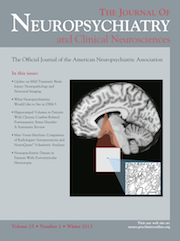Efficacy of Plasma Exchange in Pharmaco-Resistant Acute Mania in Systemic Lupus Erythematosus
To the Editor: Systemic lupus erythematosus (SLE) is an autoimmune disease that can affect any part of the body, including the central nervous system. Psychiatric manifestations during SLE are not unusual; their characteristic features are early occurrence and clinical polymorphism.1,2 This clinical case shows a picture of SLE in which the first manifestations were psychiatric, with, in particular, an episode of mania3 with delirium that was resistant to drug treatment but responded well to plasmapheresis.
A 28-year-old, socially well-integrated woman without psychiatric antecedents, was admitted in restraint to our psychiatric ward, after presenting herself at a police station clad only in an overcoat and unable to give her identity. She presented with spatiotemporal disorientation, muddled thinking, mental automaticity, vivid delirium of polymorphic content, and hetero-aggressivity. Somatic and neurological examination results were unexceptional, and the biological analysis results showed leuconeutropenia and a high sedimentation time. Serological tests for syphilis, HIV, HVB, and HVC were negative, and a brain scan and EEG showed no anomalies. A nonspecified psychotic state was diagnosed, and an antipsychotic treatment combining risperidone and loxapine was given.
After 3 weeks in the hospital, with a favorable progression and near-complete regression of the delirium, the patient suddenly relapsed, presenting a manic state with psychotic symptoms and megalomaniac delirium.
Treatment with olanzapine was started, and loxapine was maintained at a higher dose of 600 mg/day. A thymoregulator (valproic acid) was added 2 weeks later, as the symptoms did not improve.
The symptoms of acute mania were accompanied by an episode of fever, a malar erythema, multiple joint pain of the upper limbs, ulceration of buccal and vulvar mucosae, and Raynaud’s syndrome. Biological analysis showed a slight normocytic anemia and leucopenia with neutropenia and lymphopenia. Strongly positive antinuclear antibodies were found (titer above 1/1,280, speckled type). Native anti-DNA antibodies also tested positive, together with anti-RNP/Sm and anti-SSA/RO antibodies. The total complement was lowered, with a collapse of fraction C4.
The diagnosis of a severe flare-up of SLE was therefore made. In association with the psychotropic treatment, a course of cyclophosphamide was given every 3 weeks at 0.6 mg/m3. Progression in 1 month was marked by normalizing of biological analysis, but mania symptoms worsened, with more severe behavioral disorders requiring near-continual isolation of the patient. Brain MRI still showed no sign of vascularity.3
Therefore the psychotropic treatments were discontinued, and, for maniac symptoms, indication was given for a series of six plasma exchanges.
We noted an improvement in the psychiatric symptoms immediately after the first plasmapheresis. After the third plasma exchange session, a regression of the mania symptoms was observed. There still remained brief and fluctuating auditory hallucinations, which totally disappeared 2 weeks after the last plasmapheresis session, marking the total regression of all psychiatric symptoms.
No psychiatric treatment was resumed, and no psychiatric relapse has been reported after 1 year of follow-up.
To our knowledge, this clinical case is the first description of indication and utilization of plasma exchange for a manic state secondary to an SLE flare-up.
1 : Neuropsychological function in systemic lupus erythematosus: a five-year longitudinal study. Rheumatology (Oxford) 2002; 41:411–415Crossref, Medline, Google Scholar
2 : Psychosis leading to the diagnosis of unrecognized systemic lupus erythematosus: a case report. Rheumatol Int 2007; 27:883–885Crossref, Medline, Google Scholar
3 : Neuropsychiatric lupus: clinical and imaging aspects. Bull NYU Hosp Jt Dis 2007; 65:194–199Medline, Google Scholar
4 . Neuropsychiatric systemic lupus erythematosus presenting as bipolar I disorder with catatonic features. Psychosomatics 2009; 50:543–547Crossref, Medline, Google Scholar



